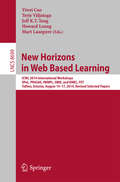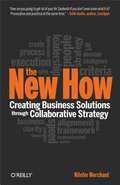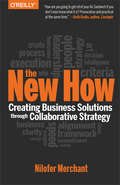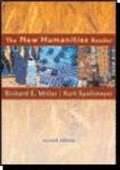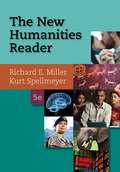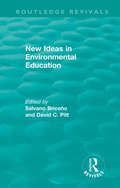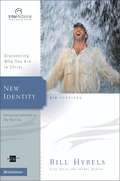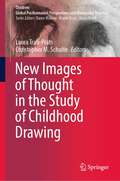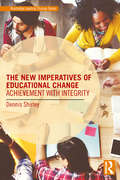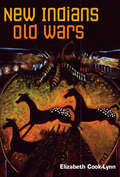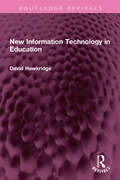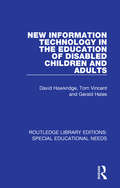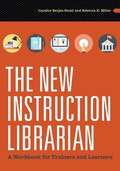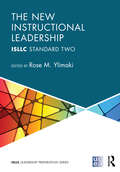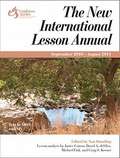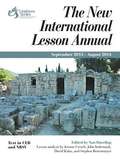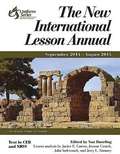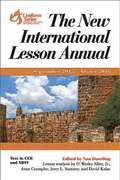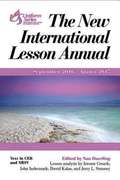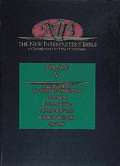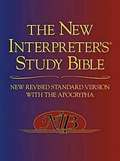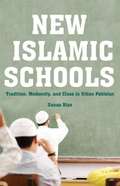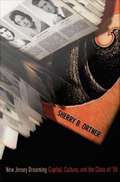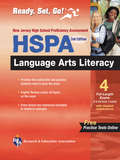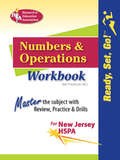- Table View
- List View
New Horizons in Web Based Learning
by Yiwei Cao Terje Väljataga Jeff K.T. Tang Howard Leung Mart LaanpereThis book constitutes the revised selected papers of the workshops of the 13th International Conference of Web-based Learning, ICWL 2014, held in Tallinn, Estonia, in August 2014. This volume comprises papers of six workshops: 1. The Seventh International Workshop on Social and Personal Computing for Web-Supported Learning Communities (SPeL 2014) 2. The First International Workshop on Peer-Review, Peer-Assessment, and Self-Assessment in Education (PRASAE 2014) 3. International Workshop on Mobile and Personalized Learning (IWMPL 2014) 4. The First International Workshop on Open Badges in Education (OBIE 2014) 5. The Fourth International Symposium on Knowledge Management & E-Learning (KMEL 2014) 6. The Future of e-Textbooks Workshop (FeT 2014).
The New How
by Nilofer MerchantWhat people are saying about The New How "How are you going to get rid of your Air Sandwich if you don't even know what it is? Provocative and practical at the same time." --Seth Godin, author of Linchpin "The New How is informative and provides exciting insights because the suggestions are practical and doable. Merchant gets the new reality--leadership fails not so much from flawed strategy as it does from failed processes of engagement from those responsible for implementing the strategy. In high-performing organizations, everyone acts like a leader, and they own the strategy and take actions to ensure its success. If you care about making a difference, read this book." --Barry Posner, author of The Leadership Challenge "Collaboration is a powerful, competitive weapon: this book shows you how to use it to win markets." --Mark Interrante, VP Content Products, Yahoo, Inc. "In a world in which the pace of change is ever quickening, collaboration, not control, is the route to a successful organization. This book tells you how to make your organization collaborative. And Nilofer Merchant's writing is a model of clarity." --Barry Schwartz, author of The Paradox of Choice: Why More Is Less "Want to transform your organization into a collaborative enterprise? Nilofer Merchant provides insightful and practical strategies in The New How." --Padmasree Warrior, CTO, Cisco Systems, Inc. "Merchant's book is a practical guide for the journey from strategy to implementation. The collaborative tools described here can help companies reach strategic success--and avoid pitfalls along the way." --Tom Kelley, General Manager, IDEO, and author of Ten Faces of InnovationOnce in a generation, a book comes along that transforms the business landscape. For today's business leaders, The New How redefines the way companies create strategies and win new markets. Management gurus have always said "people matter." But those same gurus still relegate strategy to an elite set of executives who focus on frameworks, long presentations, and hierarchical approaches. Business strategy typically has been planned by corporate chiefs in annual meetings, and then dictated to managers to carry out. The New How turns that notion on its head. After many years of working with Apple, Adobe, HP, and many other companies, Nilofer Merchant discovered the secret sauce: the best way to create a winning strategy is to include employees at all levels, helping to create strategy they not only believe in, but are also equipped to implement. In The New How, Nilofer shows today's corporate directors, executives, and managers how they can transform their traditional, top-down approach to strategy planning and execution into collaborative "stratecution" that has proven to be significantly more effective. Enhance performance and outcomes by deflating the "air sandwich" between executives in the boardroom and employees Recognize that strategy and execution are thoroughly intertwined Understand how successful strategy is founded in effective idea selection-a pile of good ideas doesn't necessarily build good strategy Create company strategy and link it to targeted execution, using the practical models and techniques provided
The New How [Paperback]: Creating Business Solutions Through Collaborative Strategy
by Nilofer MerchantWhat people are saying about The New How "How are you going to get rid of your Air Sandwich if you don't even know what it is? Provocative and practical at the same time."--Seth Godin, author of Linchpin" The New How is informative and provides exciting insights because the suggestions are practical and doable. Merchant gets the new reality--leadership fails not so much from flawed strategy as it does from failed processes of engagement from those responsible for implementing the strategy. In high-performing organizations, everyone acts like a leader, and they own the strategy and take actions to ensure its success. If you care about making a difference, read this book."--Barry Posner, author of The Leadership Challenge"Collaboration is a powerful, competitive weapon: this book shows you how to use it to win markets."--Mark Interrante, VP Content Products, Yahoo, Inc."In a world in which the pace of change is ever quickening, collaboration, not control, is the route to a successful organization. This book tells you how to make your organization collaborative. And Nilofer Merchant's writing is a model of clarity."--Barry Schwartz, author of The Paradox of Choice: Why More Is Less"Want to transform your organization into a collaborative enterprise? Nilofer Merchant provides insightful and practical strategies in The New How."--Padmasree Warrior, CTO, Cisco Systems, Inc."Merchant's book is a practical guide for the journey from strategy to implementation. The collaborative tools described here can help companies reach strategic success--and avoid pitfalls along the way."--Tom Kelley, General Manager, IDEO, and author of Ten Faces of InnovationOnce in a generation, a book comes along that transforms the business landscape. For today's business leaders, The New How redefines the way companies create strategies and win new markets.Management gurus have always said "people matter." But those same gurus still relegate strategy to an elite set of executives who focus on frameworks, long presentations, and hierarchical approaches. Business strategy typically has been planned by corporate chiefs in annual meetings, and then dictated to managers to carry out. The New How turns that notion on its head. After many years of working with Apple, Adobe, HP, and many other companies, Nilofer Merchant discovered the secret sauce: the best way to create a winning strategy is to include employees at all levels, helping to create strategy they not only believe in, but are also equipped to implement.In The New How, Nilofer shows today's corporate directors, executives, and managers how they can transform their traditional, top-down approach to strategy planning and execution into collaborative "stratecution" that has proven to be significantly more effective. Enhance performance and outcomes by deflating the "air sandwich" between executives in the boardroom and employees Recognize that strategy and execution are thoroughly intertwined Understand how successful strategy is founded in effective idea selection-a pile of good ideas doesn't necessarily build good strategy Create company strategy and link it to targeted execution, using the practical models and techniques provided
New Humanities Reader
by Richard E. Mitler Kurt SpellmeyerThe New Humanities Reader presents 32 challenging and important essays from diverse fields that address current global issues. The authors contend that there is a crisis within the humanities today due to specialization within narrow fields of scholarship, resulting in a higher education system that produces students who lack the general cross-disciplinary knowledge needed to better understand today's complex world. The selections encourage students to synthesize and think critically about ideas and research formerly kept apart. This approach challenges readers to resist mimetic thinking and instead creatively connect ideas to help them understand and retain what they read. Through this process of reading, discussing, and writing, students develop the analytical skills necessary to become informed citizens. Focused on today's issues, the selections represent both well-known nonfiction authors and newly published writers and are drawn from such periodicals as The New Yorker and Natural History and from best-selling books including Reading Lolita in Tehran, Fast Food Nation, and Into the Wild. Students will be engaged by reading and rereading, analyzing and working with these selections not simply because they are models of good writing, but because they are also deeply thought-provoking pieces that invite readers to respond.
The New Humanities Reader (Fifth Edition)
by Richard E. Miller Kurt SpellmeyerTHE NEW HUMANITIES READER presents 25 challenging and important essays from diverse fields that address current global issues. This cross-disciplinary anthology helps readers attain the analytical skills necessary to become informed citizens. Ideas and research from wide-ranging sources provide opportunities for readers to synthesize materials and formulate their own ideas and solutions. The thought-provoking selections engage and encourage readers to make connections for themselves as they think, read, and write about the events that are likely to shape their lives. The fifth edition includes nearly 50 percent new reading selections, which continue to make this text current, globally oriented, interdisciplinary, and probing.
New Ideas in Environmental Education (Routledge Revivals)
by Sálvano Briceño David C. PittOriginally published in 1988, this book was a plea for new approaches to environmental education. In the years prior to publication there had been a reappraisal of education and a growing awareness of the problems of environment and development. However, the movements had rarely met. The objective of this book was to present some of the ideas and the action that was taking place at the time. It was put forward for discussion because a major intergovernmental meeting took place in 1987, ten years on from the famous Tbilisi meeting, the world's first intergovernmental conference on environmental education. With environmental education still very much on the world’s agenda today, this title can be used as a resource to show where it all began.
New Identity
by Bill Hybels Kevin HarneyDiscover an identity that fits you for kingdom service. As a Christian, you have received more than God's forgiveness. You also have a brand new identity! You are a new creation in Christ, with fresh and exciting privileges and responsibilities. And God wants you to walk confidently in this identity, serving Him with joy and energy in your various roles as • A son or daughter of God • A saint of God • A soldier of God • An ambassador of God • A friend of God • A manager of God's resources New Identity gives you a close-up view of these different roles and equips you with the sound biblical insights you need to fulfill them. You'll discover new ways to make your citizenship in God's kingdom a daily reality right where you live. Interactions—a powerful and challenging tool for building deep relationships between you and your group members, and you and God. Interactions is far more than another group Bible study. It's a cutting-edge series designed to help small group participants develop into fully devoted followers of Christ.
New Images of Thought in the Study of Childhood Drawing (Children: Global Posthumanist Perspectives and Materialist Theories)
by Laura Trafí-Prats Christopher M. SchulteThis book provides a revitalised account of the study of children’s drawing by outlining a departure from existing approaches privileging developmentalist accounts and presenting drawing as a specialised human endeavour separated from other material entanglements constituting children’s everyday experiences. The book takes on current developments in the fields of early childhood arts and early childhood literacies to advocate for process-oriented, new materialist and decolonial approaches that re-conceptualise the study of children’s drawing. It proposes a future-oriented approach, centred on thinking experimentally with a focus on nonrepresentational elements, such as movement, sensation, intensity, rhythm, story and place, which singularly assemble in drawing events. Thus, the book discusses drawing as a process of sense-making that is not enclosed in the individualised body of the child and that unfolds corporeally in time and space. It revises the relation of drawing with symbolisation by suggesting that the use of language and signs in drawing form in entanglement with matter and sensation in processes of creative speculation connected with the movement of thought. Presenting a series of contributions by internationally recognised scholars and artists, the book aims to create synergies between theory and practice that speak of everyday realities interconnecting children, learning and sense-making.
The New Imperatives of Educational Change: Achievement with Integrity (Routledge Leading Change Series)
by Dennis ShirleyThe New Imperatives of Educational Change is a clarion call to move beyond the standardized testing and marketplace competition that have become pervasive in school systems to focus instead on creating the conditions that will encourage all students to become critical and independent thinkers. Dennis Shirley presents five new imperatives to guide educators and policymakers towards a re-thinking of what it means to teach effectively and to learn in depth. The evidentiary imperative requires educators to attain a better grasp of what data actually reveal about international trends in student learning. The interpretive imperative encourages mindful deliberation before acting on evidence in order to promote the integrity of a school community. The professional imperative describes new international research findings on promising pedagogies and curricula that propel learning in new directions. The global imperative argues that we all must look beyond our national boundaries to improve the flourishing of all young people, wherever they may be found. Finally, the existential imperative reminds us that students look to their teachers as role models who can dignify learning with meaning and embellish life with joy. Visionary in its scope and practical in its details, The New Imperatives of Educational Change is an indispensable road map for all teachers, principals, and system leaders.
New Indians, Old Wars
by Elizabeth Cook-LynnChallenging received American history and forging a new path for Native American studies Addressing Native American Studies' past, present, and future, the essays in New Indians, Old Wars tackle the discipline head-on, presenting a radical revision of the popular view of the American West in the process. Instead of luxuriating in its past glories or accepting the widespread historians' view of the West as a shared place, Elizabeth Cook-Lynn argues that it should be fundamentally understood as stolen. Firmly grounded in the reality of a painful past, Cook-Lynn understands the story of the American West as teaching the political language of land theft and tyranny. She argues that to remedy this situation, Native American studies must be considered and pursued as its own discipline, rather than as a subset of history or anthropology. She makes an impassioned claim that such a shift, not merely an institutional or theoretical change, could allow Native American studies to play an important role in defending the sovereignty of indigenous nations today.
New Information Technology in Education (Routledge Revivals #32)
by David HawkridgeFirst published in 1983, New Information Technology in Education surveyed developments in the field of information technology and demonstrated how it could be used to improve the quality of education. The book considered the experience of a wide range of countries, including the United States, Japan and those in Europe. While explaining the potential improvements that the new technology could bring, this book also reviewed the problem areas and helped educationalists to evaluate the relevance of the new technology for their own work. In an age of teaching via Zoom videos, it is interesting to take a look at a time when information technology in education was at its nascent stage. This book will be of interest to teachers and students of history, education, technology and pedagogy.
New Information Technology in the Education of Disabled Children and Adults (Routledge Library Editions: Special Educational Needs #32)
by David Hawkridge Tom Vincent Gerald HalesFirst published in 1985. Information technology can offer huge benefits to the disabled. It can help many disabled people to overcome barriers of time and space and to a much greater extent it can help them to overcome barriers of communication. In that way new information technology offers opportunities to neutralise the worst effects of many kinds of disablement. This book reviews the possibilities of using information technology in the education of the disabled. Commencing with an assessment of the learning problems faced by disabled people, it goes on to look at the scope of information technology and how it has been used for the education of students of all ages, particularly in the United Kingdom and the United States. A penultimate section considers most of the contentious issues that faced users of technology, whilst the conclusion devotes itself to the immediate and longer-term future, suggesting possible future trends and the consequent problems that may arise.
The New Instruction Librarian: A Workbook for Trainers and Learners
by Candice M. Benjes-Small Rebecca K. Miller<p>The sheer amount of resources on the subject of information literacy is staggering. Yet a comprehensive but concise roadmap specifically for librarians who are new to instruction, or who are charged with training someone who is, has remained elusive. Until now. This book cuts through the jargon and rhetoric to ease the transition into library instruction, offering support to all those involved, including library supervisors, colleagues, and trainees. Grounded in research on teaching and learning from numerous disciplines, not just library literature, this book: <p> <li>shows how to set up new instruction librarians for success, with advice on completing an environmental scan, strategies for recruiting efficiently, and a training checklist; <li>walks readers step by step through training a new hire or someone new to instruction, complete with hands-on activities and examples; <li>explores the different roles an instruction librarian is usually expected to play, such as educator, project manager, instructional designer, and teaching partner; <li>demonstrates the importance of performance evaluation and management, including assessment and continuing education, both formal and informal; and <li>provides guided reading lists for further in-depth study of a topic.</li> <p> <p>A starter kit for librarians new to instruction, this resource will be useful for training coordinators as well as for self-training.</p>
The New Instructional Leadership: ISLLC Standard Two (PSEL/NELP Leadership Preparation)
by Rose M. YlimakiCo-published with UCEA, this exciting new textbook is the first to tackle the ISLLC Standard 2—Instructional Leadership. In light of recent curriculum reforms, accountability policies, and changing demographics, today’s leaders must not only have expertise in culture building and supervision skills, but also in adult learning, cultural funds of knowledge, curriculum, and the role of politics. The New Instructional Leadership helps aspiring school leaders examine their beliefs and practices about instructional leadership in relation to ISLLC Standard 2 and provides the theory, learning experiences, and analytical tools for effective leadership in today’s world. Chapters cover issues of collaboration, curricular programming, motivation, supervision, accountability, capacity building, use of technology, monitoring, and evaluation. Special Features: Case Studies—encourage readers to reflect and actively engage with instructional leadership beliefs and practices. Fieldwork and Extended Reflections—a range of inquiry activities provide students with opportunities to consider problems of practice related to the standard. Strategies for Leaders—offers students practical and accessible ideas in order to transform their practice to address the complex challenges facing contemporary schools. Theoretically grounded and research-based, this unique volume will help aspiring and current leaders to understand instructional leadership and help them to sustain strong curricular and instructional programs in their increasingly diverse schools and communities.
New International Lesson Annual 2010-11
by Nan DuerlingThe standard resource for teachers of the Uniform Lesson Series. This resource provides 52 weekly step-by-step lesson plans for an entire year's worth of material.Includes: Lesson analysis Bible background, occasional quarterly maps or timelines, and index to background Scriptures Articles for teachers on spiritual formation Eight pages of Bible interpretation and step-by-step lesson plans "Faith in Action" section to suggest ways to put lesson concepts into action The only lesson commentary with popular and easy-to-understand New Revised Standard Version (NRSV) and New International Version (NIV)
The New International Lesson Annual 2013-2014
by Nan Duerling John Indermark Jerome F.D. Creach David Kalas Stephen C. RettenmayerYears of reader evaluations yield a record of overwhelming positive teaching results. Teachers agree that The New International Lesson Annual gets highest marks for helping Christian educators in the classroom, making Scripture understandable or intelligible, relating Scripture to contemporary living, and challenging students to respond with positive life-changing actions. Based on the Bible study foundations of America's leading ecumenical Bible educators and editors in the venerable Committee on Uniform Series. Inside discover: * Easy-to-use design with tint boxes, thumb index, goals for learners, and a key-word pronunciation guide * Easy-on-the-eyes clear type * The only lesson commentary with popular easy-to-understand NRSV and CEB translations (Combined with your own King James Bible, NIV, or any other Bible translation, you have a multiversion parallel.) [Karla, multi- forms a closed compound] * Eight pages of Bible background, interpretation, and step-by-step lesson plans keyed to learner goals for each lesson make lesson preparation thorough without requiring difficult and tedious research * In-depth quarterly teacher enrichment articles and Bible background covering both the big picture and close-up views. Complete index to background Scriptures and occasional additional helps such as maps, charts, and timelines * "Faith in Action" section gives ideas for placing faith concepts of the lessons into action * "Preparing Our Hearts" section with Bible reading and reflection questions for the teacher's personal spiritual growth * "Continue the Journey" section includes ideas for prayer, learner preparation for next week's session, activities the learners can do during the coming week to live out what they have learned, and a suggested closing hymn and benediction * Edited by one of the nation's leading Christian educators, Dr. Nan Duerling
The New International Lesson Annual 2014-2015
by Nan DuerlingYears of reader evaluations yield a record of overwhelming positive teaching results. Teachers agree that The New International Lesson Annual gets highest marks for helping Christian educators in the classroom, making Scripture understood, relating Scripture to contemporary living, and challenging students to respond with positive actions. Based on the Bible study foundations of America's leading ecumenical Bible educators and editors in the venerable Committee on Uniform Series. Lessons for a full year include analysis by leading scholars, four quarterly Bible background articles, a Teacher Helps article, and helps put faith into action. The annual uses NRSV and CEB text.
The New International Lesson Annual 2015 - 2016
by Nan DuerlingYears of reader evaluations yield a record of overwhelming positive teaching results. Teachers agree that The New International Lesson Annual gets highest marks for helping Christian educators in the classroom, making Scripture understood, relating Scripture to contemporary living, and challenging students to respond with positive actions. Based on the Bible study foundations of America's leading ecumenical Bible educators and editors in the venerable Committee on Uniform Series. Lessons for a full year include analysis by leading scholars, four quarterly Bible background articles, a Teacher Helps article, and helps put faith into action. The annual uses CEB and NRSV text.
The New International Lesson Annual 2016-2017: September 2016 - August 2017
by Jerome F.D. Creach John Indermark Nan Duerling David Kalas Jerry L. SumneyThe New International Lesson Annual is designed for teachers who seek a solid biblical basis for each session and a step-by-step teaching plan that will help them lead their classes. It can be used with any student curriculum based on the Uniform Lesson Series. In many classes, both the students and teacher rely on the Annual as their companion to the Bible. Over the four quarters of the 2016-2017 Sunday school year we will explore the themes of God's sovereignty, creation, love, and call. During the fall quarter we examine Isaiah, Hebrews, and Revelation to see how these books reveal the Sovereignty of God. Luke's Gospel, selected psalms, and Galatians will help us understand Creation: A Divine Cycle, our study for the winter. In the spring we will survey both the Old and New Testaments to discover that God Loves Us. We conclude during the summer with God's Urgent Call, a study of the way God spoke to certain judges, prophets, and people of the New Testament. Inside discover: Weekly Scripture reading and reflection questions to enhance the teacher's personal spiritual growth. Weekly activities that the learners can do beyond the classroom to live out what they have learned. In-depth background article for each quarter. Quarterly pronunciation guide. Additional quarterly reference material, such as maps, charts, or timelines. Quarterly ideas for putting one's faith into action. Annual teacher enrichment article. Annual index to background Scriptures.
The New Interpreter's Bible, Volume 5: Introduction to Wisdom Literature, Proverbs, Ecclesiastes, Canticles (Song of Songs), Book of Wisdom, Sirach
by Leander E. Keck Thomas G. Long David L. Petersen Bruce C. Birch John J. Collins Katheryn Pfisterer Daar William L. Lane James Earl Massey Gail R. O'DayIntroduction to Wisdom Literature; Proverbs; Ecclesiates. New Interpreter's® Bible offers critically sound biblical interpretations for the 1990s and beyond. Guided by scholars, pastors, and laity representing diverse traditions, academic experience, and involvement in the Church, this entirely new collection of writings is specifically prepared to meet the needs of preachers, teachers, and all students of the Bible. Easy-to-use Format: * Full texts and critical notes: NIV and NRSV * A detailed, critical Commentary providing an exegetical "close-reading" of the biblical text * Reflections that present a detailed exposition of issues raised in the discussion and dealt with in the Commentary Key Features: * The entire Bible (including the Apocrypha Deuterocanonical books) in twelve volumes * Introductions to each book that cover essential historical, sociocultural, literary, and theological issues * An ecumenical roster of contributors * Comprehensive, concise articles * Numerous visual aids (illustrations, maps, charts, timelines) enhance use. Download The NIB Vol. 5 Errata Sheet
The New Interpreter's Study Bible: New Revised Standard Version with the Apocrypha
by Walter J. Harrelson Donald Senior Abraham Smith Phyllis Trible James C. VanderkamThe New Interpreter's Study Bible brings the best of biblical scholarship to the service of the Church. In this new edition based on The New Revised Standard Version of the Bible with Apocrypha, sixty distinguished scholars have provided background and insight on the biblical text. Features include extensive historical and theological annotations on the biblical text; brief introductions and outlines for each biblical book; excursuses giving further background and insight regarding particular themes and passages; and nineteen newly commissioned maps detailing the biblical world at various historical periods. Available in leather (0687278317) and on CD-Rom (068702496X).
New Islamic Schools
by Sanaa RiazStudies on Islamic schooling, particularly in Pakistan, largely focus on orthodox religious seminaries (madrasas) and presuppose that all types of religious schooling create the same religious subjectivity that is fundamentally extremist, anti-modern and anti-secular. In this groundbreaking narrative, Riaz attempts to cover this gap in ethnographic literature on Islamic education by presenting the first participant-observation based account of the new private Islamic schools that are fast becoming popular among middle and upper class urbanites. The schools combine modern secular education with traditional madrasa education. Through observations across pre-primary and Grades 1-10 subject classes, and interviews with Islamic school entrepreneurs, administrators, teachers, students and their parents associated with these schools - each catering to a different urban class - the author elucidates how the pedagogies, curriculum and the aspirations of the producers and patrons of knowledge in these schools modernize Islamic tradition to create diverse religious, secular, and class subjectivities in the students.
New Jersey Dreaming: Capital, Culture, and the Class of '58
by Sherry B. OrtnerPioneering anthropologist Sherry B. Ortner is renowned for her work on the Sherpas of Nepal. Now she turns her attention homeward to examine how social class is lived in the United States and, specifically, within her own peer group. In New Jersey Dreaming, Ortner returns to her Newark roots to present an in-depth look at Weequahic High School's Class of 1958, of which she was a member. She explores her classmates' recollected experiences of the neighborhood and the high school, also written about in the novels of Philip Roth, Weequahic High School's most famous alum. Ortner provides a chronicle of the journey of her classmates from the 1950s into the 1990s, following the movement of a striking number of them from modest working- and middle-class backgrounds into the wealthy upper-middle or professional/managerial class. Ortner tracked down nearly all 304 of her classmates. She interviewed about 100 in person and spoke with most of the rest by phone, recording her classmates' vivid memories of time, place, and identity. Ortner shows how social class affected people's lives in many hidden and unexamined ways. She also demonstrates that the Class of '58's extreme upward mobility must be understood in relation to the major identity movements of the twentieth century--the campaign against anti-Semitism, the Civil Rights movement, and feminism. A multisited study combining field research with an interdisciplinary analytical framework, New Jersey Dreaming is a masterly integration of developments at the vanguard of contemporary anthropology. Engaging excerpts from Ortner's field notes are interspersed throughout the book. Whether recording the difficulties and pleasures of studying one's own peer group, the cultures of driving in different parts of the country, or the contrasting experiences of appointment-making in Los Angeles and New York, they provide a rare glimpse into the actual doing of ethnographic research.
New Jersey HSPA Language Arts Literacy with Online Practice Tests
by Dana Passananti The Editors of REAIs your 11th grader ready for the NJ HSPA? REA's NJ HSPA Test Prep Gets Students Ready for the Language Arts Literacy Exam! Second Edition with Bonus Exams Online! If your child or student is in eleventh grade, then you know that all eleventh graders in New Jersey are required to pass the NJ HSPA (New Jersey High School Proficiency Assessment). This revised edition of our popular test prep gives students all the information they need to succeed on this important high-stakes exam. Fully aligned with the core curriculum standards of the NJ Department of Education, our comprehensive test prep features a targeted review of the reading and writing skills tested on the exam, plus a detailed review of standard written English. Focused lessons explain language arts literacy concepts in an easy-to-understand style that's suitable for students at any learning level. Drills and examples strengthen crucial skills and reinforce what students have learned. Test-taking tips and helpful strategies give high school students added confidence and ease anxiety before the exam. The book includes two full-length practice tests with detailed explanations of answers that allow high school students to test their knowledge and focus on areas in need of improvement. As an added bonus, two additional practice tests not found in the book are available online. Each unique practice test features automatic scoring, diagnostic feedback, and detailed explanations of answers. A special section entitled "Class & Homework Assignments" is also included for added practice. Whether used in a classroom, at home for self-study, or as a textbook supplement, teachers, parents, and students will consider this book a "must-have" prep for the HSPA. REA test preps and software have proven to be the extra support students need to pass their challenging state-required tests. Our comprehensive test preps are teacher-recommended and written by experienced educators.
New Jersey HSPA Numbers and Operations Workbook: Trade Edition
by Mel FriedmanMany students continue to struggle in high school math courses because they failed to master the basic mathematical skills. REA's new Ready, Set, Go! Workbook series takes the confusion out of math, helping students raise their grades and score higher on important exams--including the NJ HSPA. What makes REA's workbooks different? For starters, students will actually like using them. Here's why: * Math is explained in simple language, in an easy-to-follow style * The workbooks allow students to learn at their own pace and master the subject * More than 20 lessons break down the material into the basics * Each lesson is fully devoted to a key math concept and includes many step-by-step examples * Paced instruction with drills and quizzes reinforces learning * The innovative "Math Flash" feature offers helpful tips and strategies in each lesson--including advice on common mistakes to avoid * Skill scorecard measures the student's progress and success * Every answer to every question, in every test, is explained in full detail * A final exam is included so students can test what they've learned When students apply the skills they've mastered in our workbooks, they can do better in class, raise their grades, and score higher on the all-important HSPA. Some of the math topics covered in the Numbers & Operations Workbook include: * Place values * Rounding * Signed numbers * Fractions * Decimals, fractions, and percentages * Exponents * Order of operations * Integers Whether used in a classroom, for home or self study, or with a tutor, this workbook gets students ready for important math tests and exams, set to take on new challenges, and helps them go forward in their studies!
